Appliances
What Happens if a Fan Overheats?

Much like a time bomb waiting to go off, a fan that overheats can lead to serious problems for the device itself and everything around it. If a fan gets too hot, the outcomes could vary from slight nuisances to potentially disastrous situations.
In this article, we will explore the various repercussions that occur when a fan overheats. From the obvious signs of trouble to the hidden dangers lurking beneath the surface, it is crucial to understand the risks involved.
We will delve into the potential fire hazards, damage to the fan motor, risk of electrical shorts, impact on fan performance, damage to the fan blades, and the consequences for computer hardware.
Alongside these potential problems, we will also emphasize the importance of regular fan maintenance to prevent such overheating mishaps.
Key Takeaways
- Overheating fans can pose fire hazards and safety risks, including the risk of electrical shock to users.
- Damage to the fan motor can result in decreased fan performance, reduced airflow, and compromised cooling efficiency.
- Overheating fans can have negative effects on surrounding electronics, such as increased energy consumption, system crashes, and data loss.
- Continuous overheating can cause permanent damage to the fan's internal components and release unpleasant odors and potentially harmful chemicals, affecting indoor air quality.
Signs of an Overheating Fan
One of the first signs that a fan is overheating is the presence of unusual noises or vibrations. These noises and vibrations can indicate potential causes such as a damaged fan blade or a loose fan motor. Troubleshooting tips for identifying the source of these noises and vibrations include checking for any loose screws or bolts that may need tightening, as well as inspecting the fan blades for any signs of damage or wear.
Another sign of an overheating fan is a decrease in airflow. When a fan is overheating, it may struggle to push out the same amount of air as it normally would. This can be caused by a clogged air filter, which restricts the flow of air through the fan. Troubleshooting tips for this issue include cleaning or replacing the air filter to restore proper airflow.
Additionally, an overheating fan may emit a burning smell. This can be a result of a faulty motor or wiring, which can cause the fan to overheat. Troubleshooting tips for this issue include inspecting the motor and wiring for any signs of damage or overheating, and replacing any faulty components.
Potential Fire Hazards

When it comes to potential fire hazards caused by fan overheating, there are several important points to consider.
First and foremost, implementing fire prevention measures is crucial in order to minimize the risk of a fire occurring.
Additionally, it's essential to be aware of warning signs that may indicate a fan is overheating, such as unusual noises or excessive heat.
Lastly, taking immediate action, such as turning off the fan and contacting a professional for assistance, can help prevent a potentially dangerous situation from escalating.
Fire Prevention Measures
To prevent potential fire hazards caused by fan overheating, it's essential to implement effective fire prevention measures. One of the key measures is ensuring proper ventilation in the area where the fan is being used.
Proper ventilation helps dissipate the heat generated by the fan, reducing the risk of overheating and potential fire outbreaks. It's important to place the fan in a well-ventilated area, away from any obstructions that could block the airflow.
Additionally, regular cleaning and maintenance of the fan are crucial to prevent dust buildup, which can hinder proper airflow and increase the risk of overheating.
Implementing these fire prevention measures will significantly reduce the chances of fan-related fire incidents, ensuring the safety of both the equipment and the surrounding environment.
Warning Signs to Watch for
Identifying warning signs of potential fire hazards is crucial in preventing fan overheating incidents. Regular fan maintenance and troubleshooting can help identify these warning signs early on.
One key warning sign is an overheating fan motor. If the motor feels excessively hot to the touch or emits a burning smell, it may indicate an issue with the fan's internal components.
Another warning sign is abnormal noises or vibrations coming from the fan. These could be indicative of a damaged motor or loose parts, which can lead to overheating.
Additionally, if the fan suddenly stops working or experiences frequent power failures, it may be a sign of electrical issues that can potentially cause a fire.
Being attentive to these warning signs and promptly addressing them through proper fan maintenance and troubleshooting can prevent fan overheating incidents and potential fire hazards.
Immediate Action Steps
To prevent potential fire hazards from fan overheating, take immediate action by following these steps:
- Turn off the fan immediately.
- Unplug the fan from the power source.
- Allow the fan to cool down completely before attempting any troubleshooting.
- Check for any visible signs of damage, such as frayed wires or melted components.
- If there are no visible issues, carefully clean the fan to remove any dust or debris that may be causing the overheating.
Taking immediate response when a fan overheats is crucial to prevent any potential fire hazards. By turning off the fan and unplugging it from the power source, you eliminate the risk of further damage.
Allowing the fan to cool down completely before troubleshooting ensures your safety. Once cool, visually inspect the fan for any signs of damage. If no visible issues are present, cleaning the fan can help remove any dust or debris that may have caused the overheating.
Following these steps will help you address the issue and ensure the proper functioning of your fan.
Damage to the Fan Motor
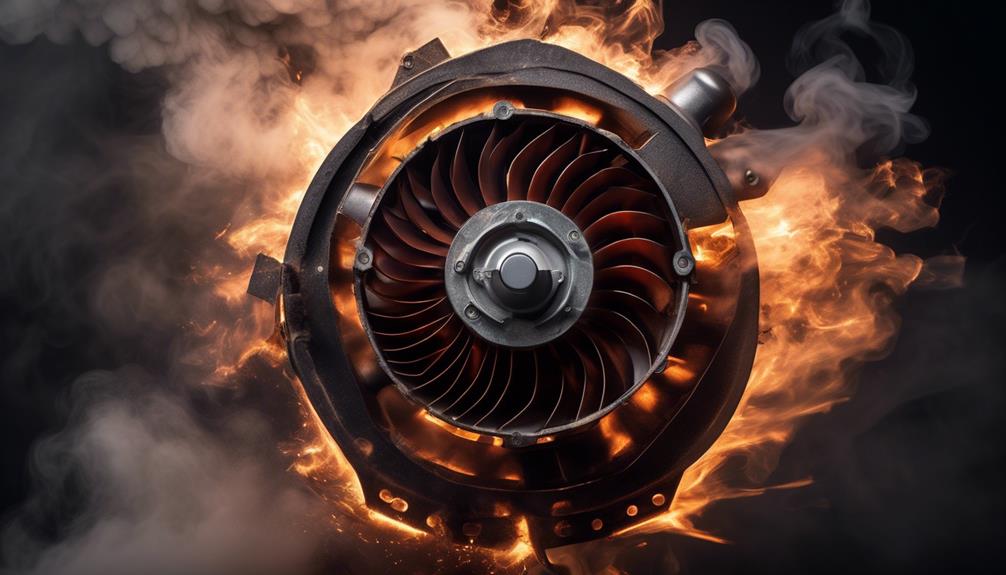
The fan motor may sustain damage due to overheating, potentially leading to a loss of functionality. When a fan overheats, the increased temperature can cause various components of the motor to malfunction or even fail completely. Let's examine the consequences of fan motor damage caused by overheating:
| Consequences of Fan Motor Damage | Description |
|---|---|
| Winding Insulation Degradation | The excessive heat can cause the insulation on the motor windings to degrade over time. This can result in short circuits or electrical failures. |
| Bearing Failure | The increased temperature can cause the lubricant in the motor's bearings to break down, leading to friction and wear. This can eventually cause the bearings to seize or fail, resulting in the motor not being able to rotate. |
| Magnetic Material Demagnetization | Prolonged overheating can demagnetize the permanent magnets used in some fan motors. This reduces the motor's efficiency, leading to reduced airflow or complete motor failure. |
| Electronics Damage | In fans with electronic controls, overheating can damage the circuitry and components, rendering the fan inoperable. This can include damage to the motor controller, capacitors, or other sensitive electronic parts. |
| Motor Overload | Overheating can cause the motor to operate at higher currents, leading to increased stress on the motor windings. This can result in excessive wear, insulation breakdown, and ultimately motor failure. |
It is important to note that the severity of the damage will depend on the extent and duration of the overheating. Regular maintenance, such as cleaning the fan and ensuring proper ventilation, can help prevent fan motor damage caused by overheating.
Risk of Electrical Shorts
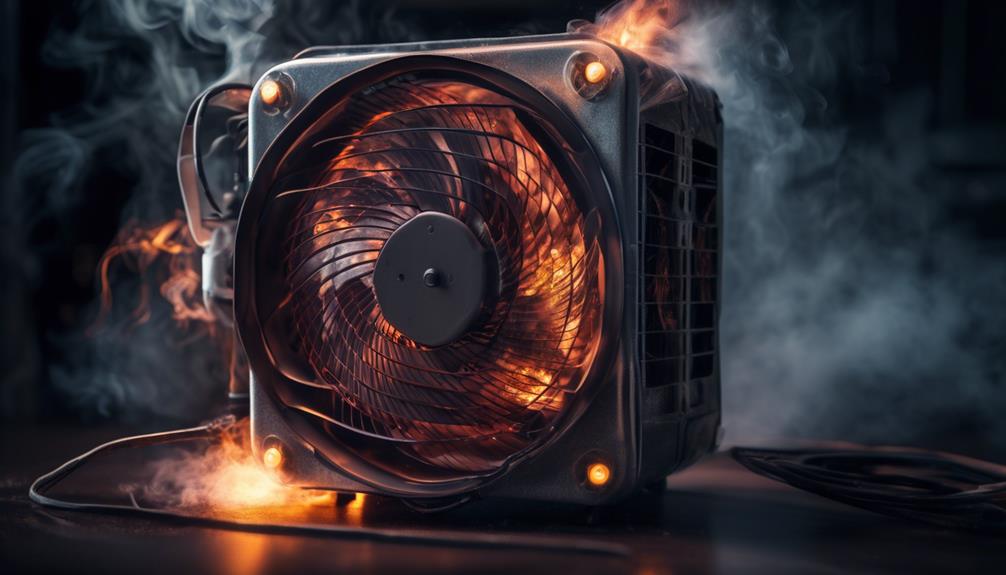
As the fan motor sustains damage due to overheating, there's an increased risk of electrical shorts occurring. Electrical shorts can pose serious risks, including the potential for fire and damage to surrounding equipment.
To mitigate these risks, it's essential to take immediate action steps and implement fire prevention measures. Here are five important points to consider:
- Inspect the fan regularly: Regular inspections can help identify any signs of damage or overheating, allowing for timely repairs or replacements.
- Keep the fan clean: Dust and debris can accumulate on the fan, increasing the risk of electrical shorts. Regular cleaning can prevent this buildup and maintain optimal performance.
- Check the wiring: Faulty or damaged wiring can lead to electrical shorts. Ensure that all wiring connections are secure and free from any signs of damage.
- Avoid overloading the fan: Overloading the fan with excessive power demands can cause the motor to overheat and increase the risk of electrical shorts. Adhere to the manufacturer's guidelines for power usage.
- Install a thermal cutoff switch: A thermal cutoff switch is a safety feature that automatically shuts off the fan if it detects excessive heat. This can prevent the fan motor from sustaining further damage and reduce the risk of electrical shorts.
Impact on Fan Performance
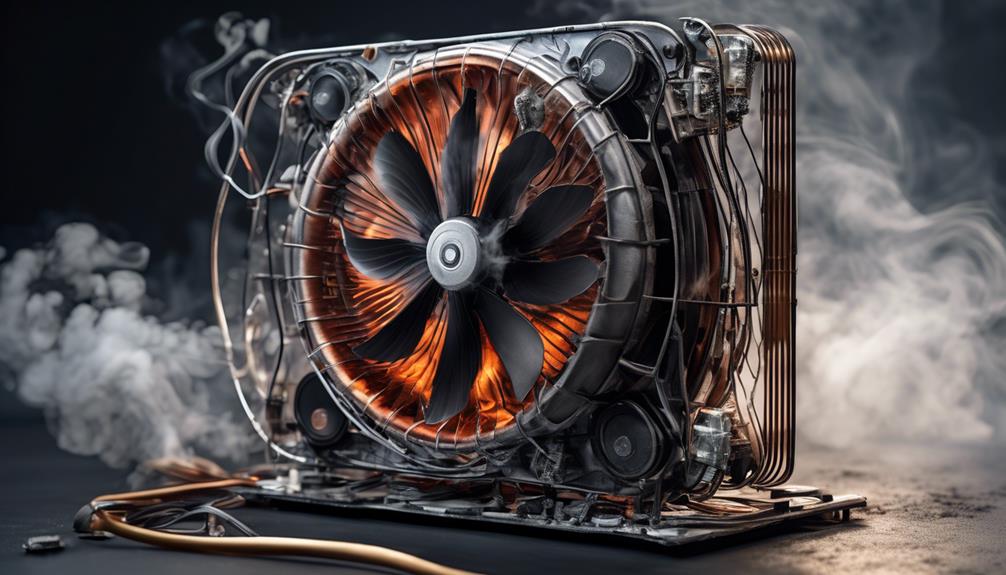
When a fan overheats, it can have a significant impact on its performance.
Firstly, the cooling effectiveness of the fan may decrease, leading to inadequate heat dissipation.
Secondly, the fan may experience potential damage or failure, resulting in the inability to function effectively.
Lastly, there are safety hazards and risks associated with an overheating fan, such as the possibility of electrical shorts or even fires.
It's crucial to address fan overheating promptly to prevent these detrimental effects.
Decreased Cooling Effectiveness
With decreased cooling effectiveness, fan performance may be significantly impacted. When a fan's cooling efficiency is compromised, it can lead to various issues that affect its overall functionality. Here are five consequences of decreased cooling effectiveness:
- Reduced airflow: The fan may struggle to circulate air efficiently, resulting in poor cooling performance.
- Increased noise levels: In an attempt to compensate for the reduced cooling capability, the fan may operate at higher speeds, generating more noise.
- Higher operating temperatures: The compromised cooling efficiency can lead to elevated temperatures within the system, potentially causing damage to sensitive components.
- Decreased lifespan: Overheating due to decreased cooling effectiveness can accelerate wear and tear on the fan, shortening its overall lifespan.
- Potential system failure: If the fan is unable to dissipate heat effectively, it can lead to system overheating, which may result in crashes or other critical failures.
To ensure optimal fan performance, regular fan maintenance and monitoring of cooling efficiency are crucial.
Potential Damage or Failure
The compromised cooling effectiveness of a fan can result in potential damage or failure, significantly impacting its performance. When a fan overheats, it can lead to various issues that may require repairs and incur potential repair costs. Additionally, the fan's reduced cooling capacity can lead to an increase in energy consumption, adversely impacting its energy efficiency.
To better understand the potential damage or failure caused by an overheating fan, let's take a look at the table below:
| Potential Damage or Failure | Impact on Fan Performance |
|---|---|
| Motor burnout | Complete fan failure |
| Damaged bearings | Noisy operation |
| Melting of wiring | Electrical malfunctions |
| Warping of fan blades | Reduced airflow |
As seen in the table, an overheating fan can experience motor burnout, damaged bearings, melting of wiring, and warping of fan blades. These issues can lead to complete fan failure, noisy operation, electrical malfunctions, and reduced airflow, respectively. It is crucial to address fan overheating promptly to prevent these potential damages and maintain optimal fan performance.
Safety Hazards and Risks
Safety hazards and risks associated with an overheating fan can significantly impact its performance and pose potential dangers to both the fan itself and its surroundings. It's crucial to understand the potential health implications and take necessary precautions to prevent any harm.
Here are some risks to consider:
- Fire hazard: Overheating fans can generate enough heat to start a fire, especially if they're placed near flammable materials.
- Electrical shock: If a fan overheats, it may cause electrical components to malfunction, increasing the risk of electrical shock to users.
- Damage to the fan: Continuous overheating can lead to permanent damage to the fan's internal components, reducing its efficiency and lifespan.
- Poor air quality: Overheating can cause the fan to release unpleasant odors and potentially harmful chemicals into the air, affecting indoor air quality.
- Risk of injury: In extreme cases, an overheating fan may explode or release hot debris, posing a risk of injury to anyone nearby.
To mitigate these risks, it's essential to regularly clean and maintain the fan, ensure proper ventilation, and never leave it unattended for long periods.
Effects on Surrounding Electronics
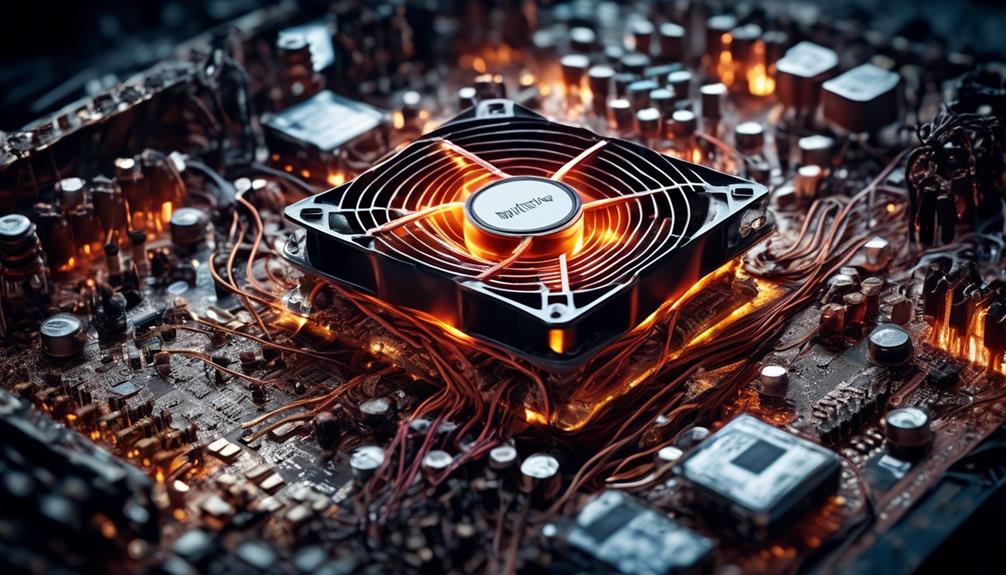
What potential risks do surrounding electronics face when a fan overheats? When a fan overheats, it can have several effects on the surrounding electronics. One major effect is the increase in energy consumption. As the fan works harder to cool the system, it requires more power, leading to higher energy usage. This can result in increased electricity costs and strain on the power supply. Additionally, the overheating fan can also have an impact on the noise levels produced by the system. As the fan spins faster to compensate for the overheating, it generates more noise, which can be disruptive to the user and those nearby.
To better understand the effects of fan overheating on surrounding electronics, consider the table below:
| Effects on Surrounding Electronics |
|---|
| Increased energy consumption |
| Impact on fan noise levels |
Strain on the Power Supply
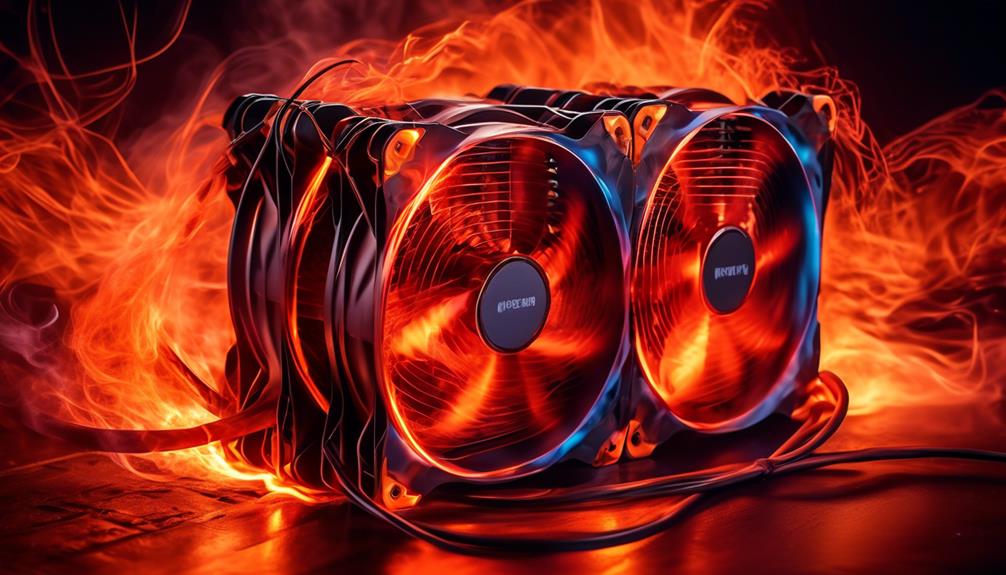
When a fan overheats and increases its energy consumption, it puts a strain on the power supply, potentially causing issues with electrical stability and performance. This strain on the power supply can have significant consequences for the overall functioning of the system. Here are five key points to consider:
- Increased power consumption: An overheating fan requires more power to operate, putting additional strain on the power supply. This increased power draw can lead to higher energy costs and potentially overload the power supply.
- Decreased cooling capacity: As the fan overheats and strains the power supply, its cooling capacity may diminish. This can result in inadequate cooling for the system, leading to further overheating and potential damage to other components.
- Reduced system stability: The strain on the power supply can lead to fluctuations in voltage and current, affecting the stability of the system. This instability can result in unexpected shutdowns, data loss, or even system crashes.
- Performance degradation: When the power supply is unable to meet the increased power demands of the overheating fan, the overall performance of the system may suffer. This can manifest as slower processing speeds, lag in graphics-intensive tasks, or decreased overall responsiveness.
- Increased risk of component failure: The strain on the power supply caused by an overheating fan can accelerate the wear and tear on other components. This increased stress can lead to premature failure of critical components, such as the motherboard, processor, or storage devices.
Understanding the strain that an overheating fan puts on the power supply is crucial in maintaining the stability and performance of the system. To prevent these issues, it's essential to address fan overheating promptly and ensure adequate cooling and power supply capacity.
Decreased Lifespan of the Fan
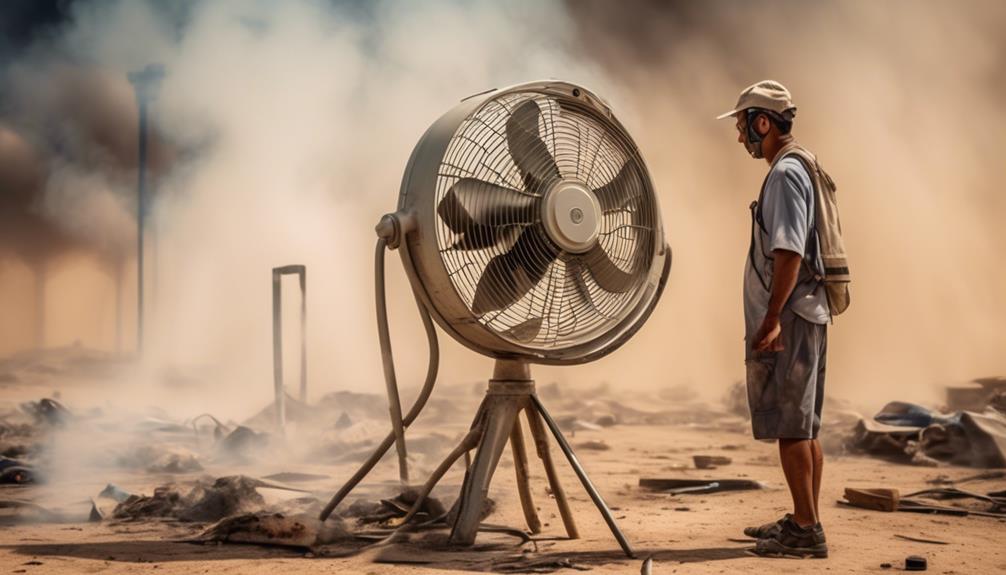
The prolonged overheating of a fan can significantly reduce its lifespan, compromising its functionality and potentially leading to costly repairs or replacements. To prevent this from happening, it is essential to perform regular fan maintenance and utilize troubleshooting techniques when necessary.
Here are some fan maintenance tips that can help extend the lifespan of your fan:
| Maintenance Tips | Description |
|---|---|
| Cleaning | Regularly clean the fan blades and remove any dust or debris. |
| Lubrication | Apply lubricant to the motor bearings to reduce friction. |
| Check electrical wiring | Inspect the fan's electrical connections for any loose wires. |
| Monitor temperature | Keep an eye on the fan's operating temperature to avoid overheating. |
| Regular inspection | Periodically inspect the fan for any signs of wear or damage. |
In addition to proper maintenance, troubleshooting techniques can also be employed to identify and resolve any potential issues:
| Troubleshooting Techniques | Description |
|---|---|
| Check power supply | Ensure the fan is receiving adequate power supply and voltage. |
| Verify fan settings | Double-check the fan settings in the system to ensure proper operation. |
| Clean air vents | Clear any obstructions in the air vents to allow for better airflow. |
| Replace faulty components | If necessary, replace any faulty components that may be causing issues. |
| Seek professional help | When all else fails, consult a professional to diagnose and fix the problem. |
Safety Risks for Users

When a fan overheats, it poses serious safety risks for users.
The first risk is the potential for user burn injuries, as the fan's components can become extremely hot and cause burns upon contact.
Second, there's a fire hazard, as overheating can lead to the ignition of nearby flammable materials.
Lastly, electrical malfunctions can occur, which may result in electric shocks or other electrical hazards.
It's crucial for users to be aware of these risks and take necessary precautions to prevent accidents and injuries.
User Burn Injuries
User burn injuries can occur as a result of prolonged exposure to the overheating fan. It's crucial for users to take proper safety precautions to prevent such injuries.
In case of burn injuries, immediate treatment is necessary to minimize damage and promote healing. Here are some important points to consider:
- First-degree burns: These are superficial burns that affect the outer layer of the skin. They usually cause redness, pain, and swelling.
- Second-degree burns: These burns penetrate deeper into the skin, causing blisters, severe pain, and potential scarring.
- Third-degree burns: These burns are the most severe and can damage all layers of the skin and underlying tissues. They may appear white, blackened, or charred.
- Cool the burn: Running cool (not cold) water over the burned area for about 20 minutes can help alleviate pain and prevent further damage.
- Seek medical attention: It's important to consult a healthcare professional for proper assessment and treatment of burn injuries.
Fire Hazards
Fire hazards pose significant safety risks for users of overheating fans. When a fan overheats, it can potentially ignite nearby objects or even start a fire, endangering lives and property. To prevent such incidents, it is crucial to emphasize fire prevention and proper fan maintenance. Regularly cleaning the fan blades and vents can help prevent the accumulation of dust and debris, which can contribute to overheating. Additionally, ensuring that the fan is placed on a stable surface, away from flammable materials, can minimize the risk of fire. It is also important to avoid overloading electrical circuits by using a fan with an appropriate power rating. By following these fire prevention measures and practicing regular fan maintenance, users can mitigate the risk of fire hazards associated with overheating fans.
| Fire Prevention | Fan Maintenance |
|---|---|
| – Clean fan blades and vents regularly | – Place fan on a stable surface |
| – Keep the fan away from flammable materials | – Avoid overloading electrical circuits |
| – Use a fan with an appropriate power rating | – Replace worn-out parts promptly |
Electrical Malfunctions
Electrical malfunctions in overheating fans can pose significant safety risks for users. When a fan overheats due to electrical malfunctions, it can lead to dangerous situations that require immediate action steps to ensure fire prevention.
Here are five potential risks associated with electrical malfunctions in overheating fans:
- Electrical sparks and short circuits, which can ignite nearby flammable materials.
- Overloading of electrical circuits, leading to potential electrical fires.
- Damage to the electrical wiring, increasing the risk of electrical shocks.
- Malfunctioning fan motors, which can emit smoke or catch fire.
- Inadequate grounding, increasing the risk of electrical accidents.
To prevent these risks, it's crucial to regularly inspect and maintain fans, ensuring that they're clean and free from dust buildup. If any signs of electrical malfunctions are detected, such as strange noises or burning smells, immediate action steps should be taken, such as unplugging the fan and contacting a qualified electrician for further inspection and repairs.
Damage to the Fan Blades
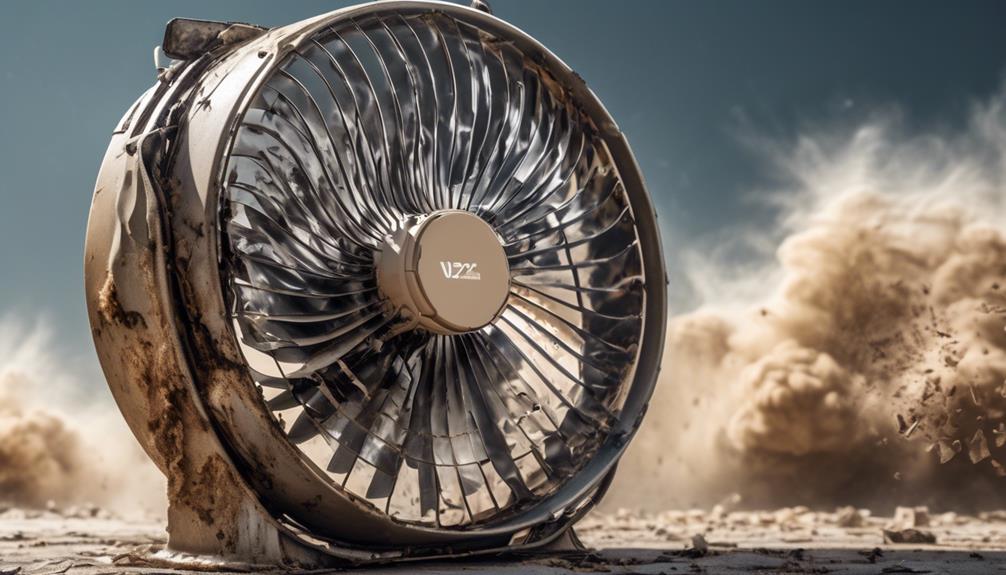
When the fan blades of a system become damaged, it can lead to a variety of issues and potential malfunctions. Fan blade maintenance is crucial to ensure optimal performance and prevent any damage that could compromise the efficiency of the fan. Regular inspection and cleaning of the fan blades are essential to remove any debris or buildup that can hinder their movement and disrupt airflow. Additionally, ensuring that the fan blades are properly balanced is important to prevent excessive vibrations that can lead to damage over time.
In some cases, despite proper maintenance, fan blades may still become damaged and require replacement. This can occur due to various reasons such as wear and tear, impact damage, or manufacturing defects. When damaged fan blades are not promptly replaced, several problems can arise, including:
- Reduced airflow: Damaged fan blades may not be able to move air effectively, resulting in reduced airflow and poor cooling performance.
- Increased noise: Misaligned or damaged fan blades can produce excessive noise during operation, leading to a noisy and unpleasant environment.
- Overheating: When damaged fan blades are unable to provide adequate airflow, it can result in overheating of the system components, potentially causing further damage or even system failure.
Proactive fan blade maintenance and timely replacement are vital to ensure the smooth operation and longevity of a system. By taking these measures, you can avoid potential malfunctions and ensure optimal cooling performance.
| Potential Issues | Consequences |
|---|---|
| Reduced airflow | Poor cooling performance |
| Increased noise | Noisy and unpleasant environment |
| Overheating | System damage or failure |
Impact on Air Circulation
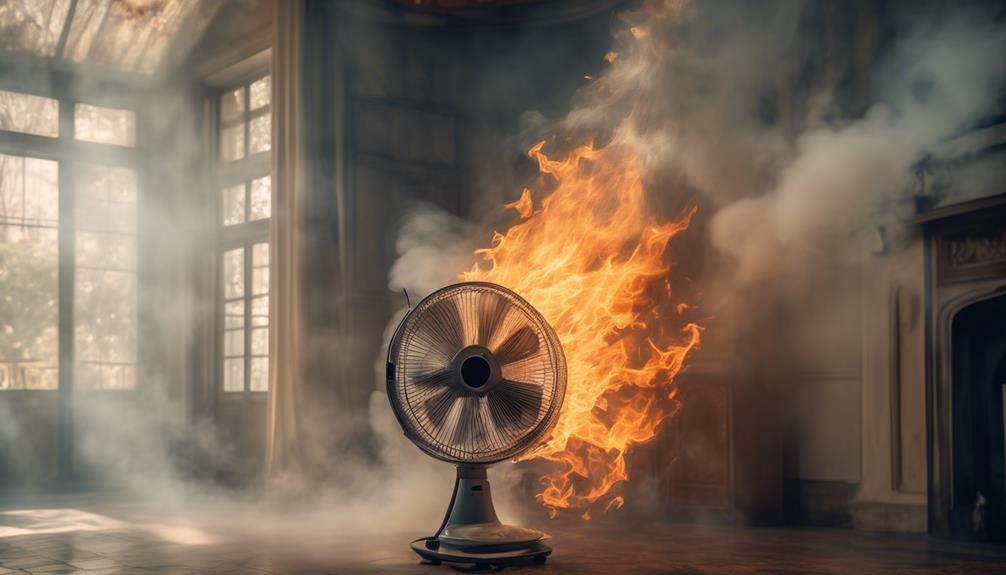
To understand the impact on air circulation, it's important to recognize how damaged fan blades can disrupt the flow of air within a system. When fan blades are damaged due to overheating, they lose their ability to efficiently move air, resulting in several negative consequences:
- Reduced airflow: Damaged fan blades can't generate the same level of airflow as their undamaged counterparts. This reduction in airflow can lead to poor ventilation and decreased cooling efficiency.
- Increased energy consumption: In order to compensate for the reduced airflow, the fan motor has to work harder, consuming more energy. This can significantly impact energy consumption and increase the overall operating costs of the system.
- Elevated noise levels: Damaged fan blades can create an unbalanced airflow, causing excessive vibrations and noise. This not only disrupts the peace and quiet but can also indicate a potential problem that needs attention.
- Inefficient cooling: A disruption in air circulation can result in uneven cooling within the system. Certain areas may receive inadequate airflow, leading to hotspots and an overall decrease in cooling effectiveness.
- Decreased system lifespan: Continuous operation with damaged fan blades can put additional strain on other components of the system, potentially shortening their lifespan. Regular maintenance and timely replacement of damaged fan blades are crucial to ensure optimal system performance and longevity.
Understanding the impact of damaged fan blades on air circulation is essential for maintaining an efficient and effective cooling system. By addressing any issues promptly, one can mitigate the negative consequences such as increased energy consumption and noise levels.
Consequences for Computer Hardware
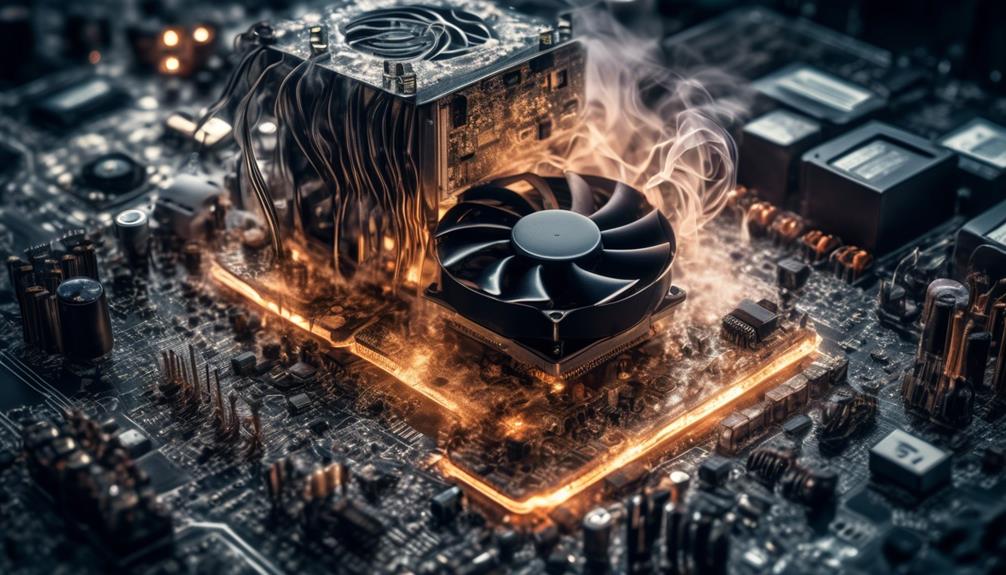
Damaged fan blades can have detrimental effects on the performance and longevity of computer hardware. When a fan overheats, it can result in various consequences for the system.
Firstly, it can lead to poor cooling of the internal components, causing them to operate at higher temperatures. This increased heat can degrade the performance and reliability of the hardware over time. Moreover, excessive heat can cause the components to throttle or even shut down to prevent damage, resulting in decreased system performance.
In addition to performance issues, an overheated fan poses a significant risk for fire. When a fan's blades are damaged or obstructed, it may not be able to effectively dissipate heat. This can lead to the accumulation of heat within the computer case, increasing the chances of a fire hazard. Therefore, proper fire prevention measures, such as regular fan maintenance and cleaning, are crucial to minimize the risk.
To prevent these consequences, it's essential to regularly inspect and clean the fan blades, ensuring they're free from dust, debris, or any obstructions. Regular maintenance helps to optimize airflow and cooling efficiency, reducing the likelihood of overheating.
Additionally, monitoring the fan's performance and promptly replacing damaged blades can help avoid potential hardware damage and extend the lifespan of the computer system.
Importance of Regular Fan Maintenance
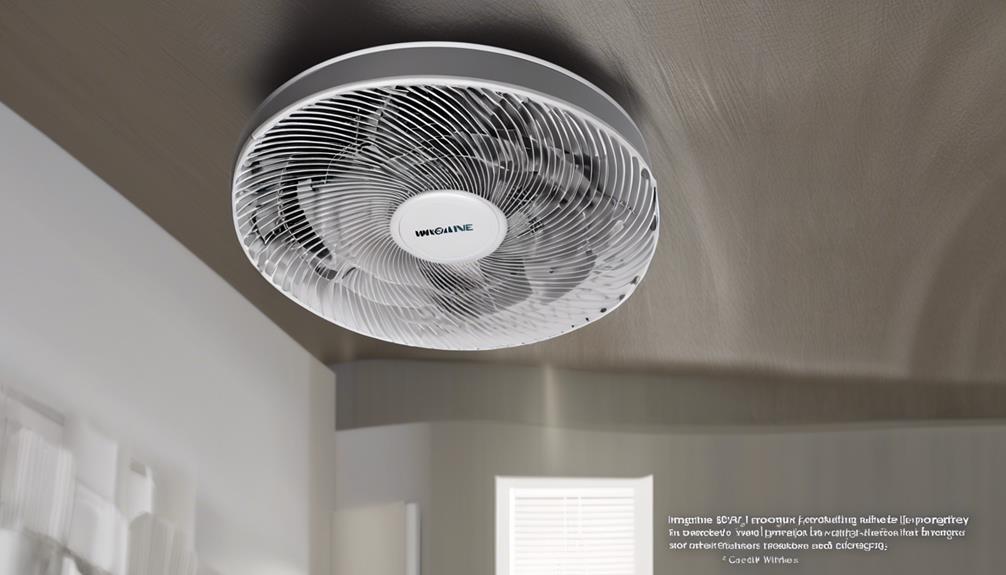
Regular fan maintenance is essential for optimal performance and longevity of computer hardware. Neglecting fan maintenance can lead to a multitude of problems, ranging from decreased cooling efficiency to complete fan failure. To emphasize the importance of regular fan maintenance, consider the following benefits:
- Improved Cooling Efficiency: Dust and debris can accumulate on the fan blades and hinder airflow, resulting in inadequate cooling. Regular cleaning ensures proper airflow and prevents overheating.
- Extended Lifespan: Over time, dust and dirt can cause the fan bearings to wear out, leading to premature fan failure. Regular maintenance, such as lubricating the bearings, can extend the lifespan of the fan.
- Reduced Noise Levels: A dirty fan can become noisy due to the buildup of debris. Regular cleaning eliminates the source of the noise, resulting in a quieter system.
- Prevention of Component Damage: Excessive heat can damage various components in your computer, such as the CPU and GPU. Proper fan maintenance helps prevent overheating, protecting your hardware from potential damage.
- Enhanced System Stability: A well-maintained fan ensures that your computer operates within safe temperature ranges, reducing the risk of system crashes, freezes, and other stability issues.
Can Overheating Fans Be Prevented by Using Reverse Fans?
Understanding reverse fan functionality can help prevent overheating fans. By using reverse fans, you can improve airflow, distribute heat more evenly, and reduce the strain on the fans. This simple solution can effectively prevent overheating and prolong the lifespan of your equipment.
Frequently Asked Questions
Can an Overheating Fan Cause Damage to Other Electronic Devices in the Vicinity?
An overheating fan can potentially cause damage to other electronic devices in the vicinity. The excessive heat generated by the fan can lead to a variety of issues, including potential fire hazards and potential damage to surrounding furniture.
It's important to ensure that the fan is properly maintained and that it has adequate ventilation to prevent overheating. Regularly cleaning the fan and checking for any obstructions can help prevent these potential damages.
What Are the Potential Safety Risks for Users if a Fan Overheats?
When a fan overheats, it poses potential safety risks and can have a significant impact on users. The heat generated by an overheating fan can lead to electrical fires, burns, or even the malfunctioning of other electronic devices in its vicinity.
Users may be exposed to the danger of fire, and the excessive heat can cause discomfort or injury.
It's crucial to address an overheating fan promptly to ensure the safety and well-being of users.
Can an Overheating Fan Lead to a Decrease in Air Circulation Within a Room?
An overheating fan can indeed lead to a decrease in air circulation within a room. When a fan overheats, its performance is compromised, resulting in reduced airflow. This can be problematic, as the purpose of a fan is to circulate air and provide cooling.
Additionally, an overheating fan may also have an impact on energy consumption, as it may require more power to function properly. Therefore, it's important to ensure that fans are regularly maintained and kept in optimal operating conditions to avoid these issues.
How Does an Overheating Fan Impact the Lifespan of the Fan Blades?
When a fan overheats, it can have a detrimental impact on the lifespan of the fan blades. The excessive heat can cause the blades to warp or become damaged, leading to decreased performance and potentially rendering the fan unusable.
To ensure the longevity of the fan blades, it's crucial to regularly clean and maintain the fan, ensuring proper airflow and preventing overheating.
Additionally, avoiding overuse and providing adequate ventilation can also contribute to prolonging the lifespan of the fan blades.
Are There Any Consequences for Computer Hardware if a Fan Overheats?
When a fan overheats, there can be potential damage and a significant impact on the performance of computer hardware. Excessive heat can cause components to malfunction or even fail, leading to system crashes or permanent damage.
The increased temperature can also reduce the efficiency of other parts, affecting overall performance. It's crucial to address any overheating issues promptly to prevent long-term consequences and ensure the longevity of the hardware.
Conclusion
In conclusion, an overheating fan can have serious consequences. It may lead to potential fire hazards, damage to the fan motor, and the risk of electrical shorts.
Additionally, the performance of the fan may be affected, and the fan blades can be damaged. This can impact air circulation and even cause damage to computer hardware.
Regular fan maintenance is crucial to prevent these issues and ensure the safe and efficient operation of the fan.
- About the Author
- Latest Posts
Introducing Ron, the home decor aficionado at ByRetreat, whose passion for creating beautiful and inviting spaces is at the heart of his work. With his deep knowledge of home decor and his innate sense of style, Ron brings a wealth of expertise and a keen eye for detail to the ByRetreat team.
Ron’s love for home decor goes beyond aesthetics; he understands that our surroundings play a significant role in our overall well-being and productivity. With this in mind, Ron is dedicated to transforming remote workspaces into havens of comfort, functionality, and beauty.
Appliances
3 Essential Tips for RV-Friendly Portable Washers

- Pros and cons of using eco friendly laundry detergent in a portable washer.
- Tips for preventing detergent residue buildup in a portable washer
Are you exhausted from constantly looking for laundromats during your RV trips? We get it. That’s why we’re here to provide three key tips for RV-friendly portable washing machines.
While you might be thinking, ‘Do I really need a portable washer?’ trust us, having one on your RV can be a game-changer. In this guide, we’ll show you how to choose the right size washer that fits your RV’s limited space, understand the power and water requirements to ensure smooth operation, and provide you with maintenance and cleaning tips to keep your washer running efficiently.
So, let’s dive in and master the art of laundry on the road!
Key Takeaways
- Consider the laundry capacity needed for your RV.
- Look for compact and lightweight options with space-saving features.
- Choose a portable washer with high energy efficiency and water conservation features.
- Regularly maintain and clean your portable washer using recommended cleaning products.
Choosing the Right Size
One of the first considerations when selecting a portable washer for our RV is determining the appropriate size. Portable washer features and space-saving options play a crucial role in making this decision. When it comes to size, it’s important to find a washer that fits well within the limited space of an RV, while still providing enough capacity to meet our laundry needs.
To begin with, portable washers come in a range of sizes, typically measured in pounds of laundry capacity. It’s essential to consider the amount of laundry we anticipate doing on a regular basis. While a smaller capacity may be suitable for individuals or couples, larger families might require a washer with a higher capacity to accommodate their laundry demands.
Additionally, it’s important to consider the physical dimensions of the washer. RVs have limited space, so opting for a compact and lightweight washer can help maximize the available room. Some portable washers are designed with space-saving features such as folding handles, detachable components, or even stackable options that can fit neatly into tight spaces.
Understanding Power and Water Requirements
When considering the power and water requirements for our RV-friendly portable washer, we need to understand the necessary resources for optimal performance.
Energy efficiency is an important factor to consider when choosing a portable washer for your RV. Look for models that have a high Energy Star rating, as this indicates that they consume less energy and can help you save on your electricity bills.

Additionally, portable washer features such as load sensing technology and adjustable water levels can help you conserve water. These features ensure that the washer only uses the amount of water necessary to clean your laundry, which is particularly crucial when you have limited water supply in your RV.
It’s also important to check the power requirements of the portable washer. Make sure that the washer is compatible with the power source available in your RV, whether it’s a standard 120-volt outlet or a 12-volt DC power source.
Understanding the power and water requirements of your RV-friendly portable washer won’t only help you achieve optimal performance but also contribute to energy and water conservation.
Maintenance and Cleaning Tips
Let’s talk about how to properly maintain and clean your RV-friendly portable washer. Taking care of your portable washer is essential to ensure its longevity and optimal performance. Regular maintenance and cleaning will help prevent any potential issues and keep your machine running smoothly. Here are some common troubleshooting tips and recommended cleaning products to keep in mind:
| Common Troubleshooting | Recommended Cleaning Products |
|---|---|
| Leaking water | Vinegar and water mixture |
| Excessive noise | Mild detergent |
| Drum not spinning | Baking soda |
| Error codes | Citric acid |
If you encounter a problem such as leaking water, try using a mixture of vinegar and water to clean the machine’s seals and hoses. For excessive noise, use a mild detergent to clean the drum and remove any debris that may be causing the noise. If the drum is not spinning, try using baking soda to remove any buildup that may be hindering its movement. Lastly, if you receive error codes, using citric acid in the detergent compartment can help clean the sensors and resolve the issue.
Remember to always refer to your portable washer’s manual for specific maintenance instructions and troubleshooting tips. By following these guidelines and using the recommended cleaning products, you can keep your RV-friendly portable washer in great condition and enjoy clean laundry on your travels.
Frequently Asked Questions
How Long Does It Typically Take to Wash a Full Load of Laundry Using a Portable Washer?
Typically, it takes around 30 to 45 minutes to wash a full load of laundry using a portable washer.
However, it’s important to consider the capacity limitations of these machines. Most portable washers have a smaller capacity compared to traditional washers, so it may take longer if you have a larger load.
It’s always a good idea to follow the manufacturer’s instructions and not overload the machine to ensure efficient and effective washing.
Can I Use Regular Laundry Detergent in a Portable Washer, or Do I Need to Use a Specific Type?
Yes, you can use regular laundry detergent in a portable washer. However, there are some pros and cons to consider.
Using eco-friendly laundry detergent in a portable washer is a great option for those who want to reduce their environmental footprint. It can be gentler on your clothes and safer for the environment.
However, some eco-friendly detergents may not be as effective at removing tough stains. To prevent detergent residue buildup, make sure to use the recommended amount of detergent and run an extra rinse cycle if needed.
Is It Safe to Leave a Portable Washer Unattended While It’s Running?
Safety precautions should be taken when using a portable washer unattended. There are potential risks involved, such as water leakage or electrical malfunctions. It’s important to follow the manufacturer’s instructions and guidelines for safe operation.
Some tips to minimize risks include ensuring a stable surface, avoiding overloading the machine, and regularly checking for any signs of damage.
It’s always best to err on the side of caution when it comes to leaving a portable washer running without supervision.
Can I Wash Delicate Fabrics, Such as Silk or Lace, in a Portable Washer?
When it comes to washing delicate fabrics like silk or lace in a portable washer, there are a few things to keep in mind.
Firstly, check the manufacturer’s instructions to ensure that your specific model is suitable for these types of fabrics.
Secondly, use a gentle cycle and cold water to minimize any potential damage.
Lastly, consider placing delicate items in a mesh laundry bag for added protection.
With these precautions, you can safely wash your delicate fabrics in an RV-friendly portable washer.

How Noisy Are Portable Washers When in Operation?
When it comes to the noise level of portable washers, it’s important to consider their energy efficiency as well. These machines are designed to be compact and efficient, so they tend to operate quietly. While they do make some noise during operation, it’s typically minimal and shouldn’t disturb your RV neighbors or disrupt your peaceful campsite.
Plus, their energy efficiency means you can enjoy clean clothes without draining your RV’s power supply.
Conclusion
In conclusion, choosing the right size portable washer for your RV, understanding power and water requirements, and following maintenance and cleaning tips are essential for a smooth laundry experience on the road.
By coincidence, we stumbled upon a fellow traveler at a campsite who’d just purchased a portable washer based on our article. They were thrilled with the convenience and efficiency it provided.
So, take these tips into consideration and enjoy clean clothes wherever your adventures take you!
- About the Author
- Latest Posts
Introducing Charles, the Editor in Chief at ByRetreat, whose passion for interior design and editorial excellence elevates every remote workspace to new heights. With his keen eye for detail, impeccable taste, and expertise in design, Charles brings a wealth of knowledge and creativity to the ByRetreat team.
As the Editor in Chief of a renowned lifestyle blog, Charles has honed his skills in curating captivating content and staying up-to-date with the latest trends in interior design. His deep understanding of aesthetics and the power of storytelling through design enables him to create remote workspaces that are not only visually stunning but also rich in personality and meaning.
Appliances
4 Smart Tips for Extended Commercial Appliance Warranties

Did you realize that nearly 80% of commercial appliance malfunctions happen after the manufacturer’s warranty runs out? As business operators, we grasp the significance of safeguarding our assets and reducing unforeseen costs.
That’s why we have compiled four smart tips for extended commercial appliance warranties that will help you make informed decisions and ensure the longevity of your appliances.
In this guide, we will discuss choosing the right warranty provider, understanding coverage and exclusions, evaluating the cost and value, and maximizing the benefits of extended warranties.
By following these tips, you can have peace of mind knowing that your appliances are protected and your business operations can continue smoothly.
Let’s dive in and master the art of extended warranties!
Key Takeaways
- Choose a warranty provider with a good reputation and track record.
- Understand the coverage details and limitations of the warranty.
- Evaluate the cost and value of extended warranties.
- Maximize the benefits by understanding the claim process and maintaining your appliances.
Choosing the Right Warranty Provider
When selecting a warranty provider for extended commercial appliance warranties, we should consider their reputation and track record in the industry. Identifying reputable providers is crucial to ensure that we’re dealing with a company that has a history of delivering on their promises and providing excellent service to their customers. A reputable provider will have a strong presence in the market and positive reviews from satisfied clients. They’ll also have a proven track record of handling warranty claims efficiently and resolving issues promptly.
In addition to reputation, it’s important to compare warranty terms offered by different providers. We should carefully review the terms and conditions of each warranty to ensure that they meet our specific needs and requirements. This includes understanding the coverage provided, such as if it includes parts and labor costs, and the duration of the warranty. It’s also important to consider any limitations or exclusions that may apply.
Understanding Coverage and Exclusions
To fully understand the extent of coverage and any exclusions, we should carefully review the warranty terms and conditions for our extended commercial appliance warranties. Many people have common misconceptions about what’s covered under these warranties, which is why it’s so important to read the fine print. Here are some key points to consider:
- Scope of coverage: It’s crucial to understand what types of repairs or replacements are included in the warranty. This may vary depending on the provider and the specific appliance being covered. Some warranties may only cover certain parts or components, while others may offer more comprehensive coverage.
- Exclusions: Even though warranties provide coverage, there are often exclusions stated in the terms and conditions. These exclusions may include damage caused by misuse, neglect, or unauthorized repairs. It’s important to be aware of these exclusions to avoid any surprises when filing a claim.
- Duration of coverage: Extended commercial appliance warranties can vary in terms of their duration. Some warranties may provide coverage for a fixed period of time, while others may offer coverage until a certain number of repairs or replacements have been made. Understanding the duration of coverage can help us plan for future maintenance and repairs.
- Claim process: Familiarizing ourselves with the claim process is essential. This includes knowing who to contact, what documentation is required, and any specific procedures that need to be followed to ensure a smooth and efficient claim experience.
Evaluating the Cost and Value
To determine the cost-effectiveness of extended commercial appliance warranties, we need to assess their overall value. When weighing options and considering budget considerations, it is essential to evaluate the benefits and drawbacks of purchasing extended warranties for your appliances. To help you make an informed decision, we have created a table that outlines the key factors to consider:
| Factors to Consider | Benefits | Drawbacks |
|---|---|---|
| Coverage | Extended protection beyond the manufacturer’s warranty period | Additional cost |
| Repair Costs | Potential savings on repair expenses | Warranty cost may outweigh repair costs |
| Peace of Mind | Assurance that your appliances are protected | Limited likelihood of appliance failure |
By considering these factors, you can determine whether the cost of an extended warranty is justified by its value. It is important to note that budget considerations should not be the sole determining factor. While extended warranties may come at an additional cost, they can provide peace of mind and potential savings on repair expenses.
In the next section, we will explore strategies for maximizing the benefits of extended warranties, ensuring that you get the most value out of your investment.
Maximizing the Benefits of Extended Warranties
To maximize the benefits of extended warranties, we can employ strategies that optimize our investment. By understanding the claim process and exploring renewal options, we can ensure that our commercial appliance warranties provide us with the maximum value and protection.
Here are some smart tips for maximizing the benefits of extended warranties:
- Thoroughly understand the claim process: Familiarize yourself with the steps involved in filing a claim. Know the required documentation, such as proof of purchase and warranty information. By being prepared, you can expedite the claim process and minimize downtime.
- Regularly maintain your appliances: Proper maintenance is crucial for the longevity and performance of your commercial appliances. Follow the manufacturer’s guidelines for cleaning, servicing, and inspections. Regular maintenance not only extends the lifespan of your appliances but also helps prevent potential issues that may require warranty claims.
- Research renewal options: When your extended warranty is about to expire, explore renewal options offered by the warranty provider. Some providers offer extended renewal plans with additional coverage, giving you continued peace of mind and protection for your investment.
- Keep warranty documents organized: Maintain a dedicated folder or digital file for all your warranty documents. This ensures easy access to necessary information when filing a claim or renewing your warranty.
Frequently Asked Questions
How Can I Extend the Warranty on My Commercial Appliance if It’s Already Expired?
To extend the warranty on your commercial appliance after it has expired, there are several renewal options available.
You can contact the manufacturer or a third-party warranty provider to inquire about their extended warranty programs. They may offer coverage plans specifically designed for appliances with expired warranty coverage.
It’s important to carefully review the terms and conditions, as well as the cost, of these extended warranty options to ensure they meet your needs and budget.
Are There Any Specific Requirements or Limitations for Obtaining an Extended Warranty for Commercial Appliances?
When obtaining an extended warranty for commercial appliances, it’s important to be aware of the common exclusions in extended warranty coverage. These may include wear and tear, cosmetic damage, and misuse or negligence.
To choose the right extended warranty, consider factors such as the length of coverage, cost, and reputation of the provider.
It’s also crucial to thoroughly read and understand the terms and conditions of the warranty to avoid any surprises down the line.
Can I Transfer My Extended Warranty to a New Owner if I Sell My Commercial Appliance?
Yes, you can transfer your extended warranty to a new owner if you sell your commercial appliance. This ensures that the warranty coverage for used appliances continues with the new owner.
It’s important to check the specific requirements and limitations of your extended warranty to ensure a smooth transfer process. By transferring the warranty, you provide peace of mind to the new owner and protect them against any unexpected repair or replacement costs.
What Happens if My Commercial Appliance Breaks Down Multiple Times During the Extended Warranty Period?
If your commercial appliance breaks down multiple times during the extended warranty period, you may be eligible for claim reimbursement. The repair or replacement timeline will depend on the terms and conditions of your warranty.
It’s important to thoroughly review the warranty agreement to understand the process and any limitations. Our team is here to help ensure that your claims are handled efficiently and that you receive the necessary repairs or replacements in a timely manner.
Is There a Limit to the Number of Claims I Can Make Under an Extended Warranty for My Commercial Appliance?
There are limitations to the number of claims we can make under an extended warranty for our commercial appliance.
However, it’s important to note that extended warranties offer numerous benefits for commercial appliances. They provide peace of mind by covering repairs and replacements, reducing downtime and maintenance costs.
Conclusion
In conclusion, when it comes to extended commercial appliance warranties, there are several crucial considerations to keep in mind.
Firstly, choosing the right provider is essential. It’s important to research and compare different warranty providers to ensure they have a good reputation and offer comprehensive coverage.
Understanding coverage and exclusions is also crucial. Businesses should carefully review the terms and conditions of the warranty to know exactly what is covered and what is not. This will help avoid any surprises or disappointments down the line.

Evaluating cost and value is another important factor. Businesses should consider the cost of the warranty in relation to the potential repair or replacement costs of the appliances. They should also assess the value of the warranty by considering additional benefits such as extended service hours or priority service.
Lastly, maximizing benefits is key. Businesses should take advantage of all the benefits offered by the warranty, such as regular maintenance or discounted repairs. This will help ensure the appliances are well-maintained and any issues are addressed promptly.
By following these smart tips, businesses can make informed decisions that protect their investments. Just like a well-oiled machine, a well-chosen warranty can provide peace of mind and keep the business running smoothly. So don’t leave your appliances vulnerable, take action and secure their longevity today.
- About the Author
- Latest Posts
Introducing Charles, the Editor in Chief at ByRetreat, whose passion for interior design and editorial excellence elevates every remote workspace to new heights. With his keen eye for detail, impeccable taste, and expertise in design, Charles brings a wealth of knowledge and creativity to the ByRetreat team.
As the Editor in Chief of a renowned lifestyle blog, Charles has honed his skills in curating captivating content and staying up-to-date with the latest trends in interior design. His deep understanding of aesthetics and the power of storytelling through design enables him to create remote workspaces that are not only visually stunning but also rich in personality and meaning.
Appliances
3 Essential DIY HVAC Maintenance Tips Unveiled

Ah, the pleasures of tending to our HVAC systems! We understand the excitement of dedicating our valuable time to the upkeep and repair of these marvelous devices. But do not worry, dear reader, as we have revealed the tips to becoming skilled at DIY HVAC maintenance.
In this guide, we will unveil three essential tips that will ensure your HVAC system remains in perfect harmony. Get ready to dive into the world of air filters, thermostat settings, and outdoor condenser units. We will show you how to clean, check, and clear with ease, all while achieving that coveted mastery over your HVAC system.
So, let’s roll up our sleeves and get down to business, shall we?
Key Takeaways
- Regular maintenance, including cleaning air filters and checking thermostat settings, is essential for optimal HVAC system performance.
- Cleaning or replacing air filters prevents clogging and maintains a healthy indoor environment.
- Checking and maintaining thermostat settings ensures accurate temperature control and programming.
- Clearing debris from the outdoor condenser unit improves its performance and prevents airflow restriction.
Cleaning Air Filters Regularly
We recommend cleaning air filters regularly to ensure proper airflow and maintain optimal HVAC system performance. Replacing air filters is a crucial part of HVAC maintenance that often gets overlooked.
Air filters play a significant role in improving indoor air quality by capturing dust, pollen, and other airborne particles. Over time, these particles can accumulate on the filters, causing them to become clogged and obstructing the airflow. This can result in reduced efficiency and increased energy consumption.
By cleaning or replacing air filters on a regular basis, you can prevent these issues and maintain a healthy indoor environment.
Cleaning air filters is a relatively simple task that can be done by the homeowner. Start by turning off the HVAC system and locating the air filter. Remove the filter and inspect it for any visible dirt or debris. If the filter is washable, gently clean it with water and a mild detergent. Allow it to dry thoroughly before reinstalling. If the filter isn’t washable, it should be replaced with a new one. Remember to check the manufacturer’s recommendations for the appropriate filter type and replacement schedule.
Checking and Maintaining Thermostat Settings
To ensure optimal HVAC system performance, it’s important to regularly check and maintain the thermostat settings. The thermostat acts as the control center for your heating and cooling system, allowing you to adjust the temperature and program a schedule that suits your needs.
Start by adjusting the temperature settings to the desired level. This can be done manually or through programming. If you prefer a consistent temperature throughout the day, programming a schedule can help save energy and maintain comfort. Make sure to set different temperatures for when you’re away from home or asleep.
Regularly check the accuracy of your thermostat by comparing it to a separate thermometer. If there’s a discrepancy, recalibrate the thermostat to ensure accurate readings.
Keep the thermostat clean and free from dust and debris. Use a soft cloth to wipe away any buildup that may affect its functionality.
Lastly, check the batteries in your thermostat. Dead or low batteries can cause the thermostat to malfunction. Replace them as needed to ensure proper operation.
Clearing Debris From Outdoor Condenser Unit
Clearing debris from the outdoor condenser unit involves removing any dirt, leaves, and other obstructions that can hinder its performance. It’s important to regularly inspect and clean the condenser coil to ensure optimal functioning of the HVAC system.
To begin, it’s crucial to remove any vegetation that may have grown around the outdoor condenser unit. Plants, shrubs, or trees that are too close to the unit can restrict airflow and reduce its efficiency. Cut back any overhanging branches or foliage that may block the airflow and impede the unit’s ability to cool the air effectively.
Next, inspect the condenser coil for any debris buildup. Over time, dirt, leaves, and other particles can accumulate on the coil, obstructing the airflow and reducing its heat transfer capabilities. Gently brush away any debris using a soft-bristle brush or a vacuum cleaner with a brush attachment. Be careful not to damage the delicate fins of the coil during the cleaning process.
In addition to removing debris, it’s essential to inspect the coil for any signs of damage or corrosion. If any bent fins are detected, use a fin comb to straighten them out carefully. If there’s significant damage or corrosion, it’s recommended to contact a professional HVAC technician for further assessment and repair.
Regularly clearing debris and maintaining the condenser coil will help ensure that the outdoor unit operates efficiently and prolong its lifespan. By following these simple steps, you can optimize the performance of your HVAC system and maintain a comfortable indoor environment.
Frequently Asked Questions
How Often Should I Clean or Replace My Air Filters?
To improve the air quality in our homes, it’s essential to clean or replace air filters regularly. So, how often should we clean or replace them?
It’s recommended to clean or replace air filters every 1 to 3 months, depending on factors like the type of filter, the level of pollutants, and the frequency of HVAC system usage. Regular maintenance ensures that the air flowing through our HVAC system is clean and healthy, promoting a comfortable and safe living environment.
Can I Use Any Type of Air Filter for My HVAC System?
Can we use any type of air filter for our HVAC system?

It’s important to understand that not all air filters are created equal. There are different types of air filters available in the market, each with its own specifications and benefits.
Using the right filter for your HVAC system is crucial in ensuring optimal performance and indoor air quality. It’s recommended to consult with a professional to determine the best filter for your specific system and needs.
Are There Any Specific Thermostat Settings I Should Be Aware of During Different Seasons?
During different seasons, it’s important to adjust thermostat programming to maximize energy efficiency. By setting higher temperatures in the summer and lower temperatures in the winter, you can reduce the workload on your HVAC system and save on energy costs.
Additionally, utilizing programmable thermostats can help automate these adjustments, ensuring optimal comfort and efficiency.
How Can I Determine if the Outdoor Condenser Unit Is Blocked by Debris?
To determine if the outdoor condenser unit is blocked by debris, we can look for certain signs.
One key indicator is reduced airflow coming from the unit. If you notice that the air isn’t flowing as strongly as before, it could be a sign of blockage.
Another sign to watch out for is unusual noises coming from the condenser, which could indicate damage.
Regularly inspecting and cleaning the unit will help prevent any potential issues and ensure optimal performance.
What Are the Potential Consequences of Not Regularly Cleaning the Air Filters or Clearing Debris From the Outdoor Condenser Unit?
Neglecting HVAC maintenance can lead to serious consequences. Regularly cleaning air filters and clearing debris from the outdoor condenser unit is of utmost importance. Failure to do so can result in reduced airflow, decreased efficiency, and higher energy bills.
Additionally, dirty filters can lead to poor indoor air quality and potential health issues. By prioritizing regular HVAC maintenance, we ensure optimal performance, extend the lifespan of our system, and create a healthier and more comfortable living environment.
Conclusion
In conclusion, by regularly cleaning air filters, checking and maintaining thermostat settings, and clearing debris from the outdoor condenser unit, homeowners can ensure optimal performance and efficiency of their HVAC systems.
These essential DIY maintenance tips not only extend the lifespan of the system but also improve indoor air quality and reduce energy consumption.
By taking these simple steps, homeowners can enjoy a comfortable and healthy living environment while saving on utility bills.
- About the Author
- Latest Posts
Introducing Charles, the Editor in Chief at ByRetreat, whose passion for interior design and editorial excellence elevates every remote workspace to new heights. With his keen eye for detail, impeccable taste, and expertise in design, Charles brings a wealth of knowledge and creativity to the ByRetreat team.
As the Editor in Chief of a renowned lifestyle blog, Charles has honed his skills in curating captivating content and staying up-to-date with the latest trends in interior design. His deep understanding of aesthetics and the power of storytelling through design enables him to create remote workspaces that are not only visually stunning but also rich in personality and meaning.
-

 Vetted2 days ago
Vetted2 days ago15 Best Folding Beds for Small Spaces – Space-Saving Solutions for Comfort and Convenience
-

 Vetted20 hours ago
Vetted20 hours ago15 Best Waterproof Flooring Options for Your Bathroom – Ultimate Guide & Reviews
-

 Vetted6 days ago
Vetted6 days ago15 Best Grocery Carts to Make Shopping a Breeze
-

 Vetted2 weeks ago
Vetted2 weeks ago15 Best Gravel for Driveway: The Ultimate Guide for a Durable and Stunning Entrance
-

 Vetted4 days ago
Vetted4 days ago15 Best Steam Generators for Showering Bliss: Reviewed & Rated
-

 Beginners Guides3 weeks ago
Beginners Guides3 weeks agoI Inhaled Vinegar Fumes
-

 Vetted2 weeks ago
Vetted2 weeks ago15 Best Hot Tubs of 2024: Luxurious Relaxation at Your Fingertips
-

 Vetted4 weeks ago
Vetted4 weeks ago15 Best Blinds for Bathroom Windows to Enhance Privacy and Style


























